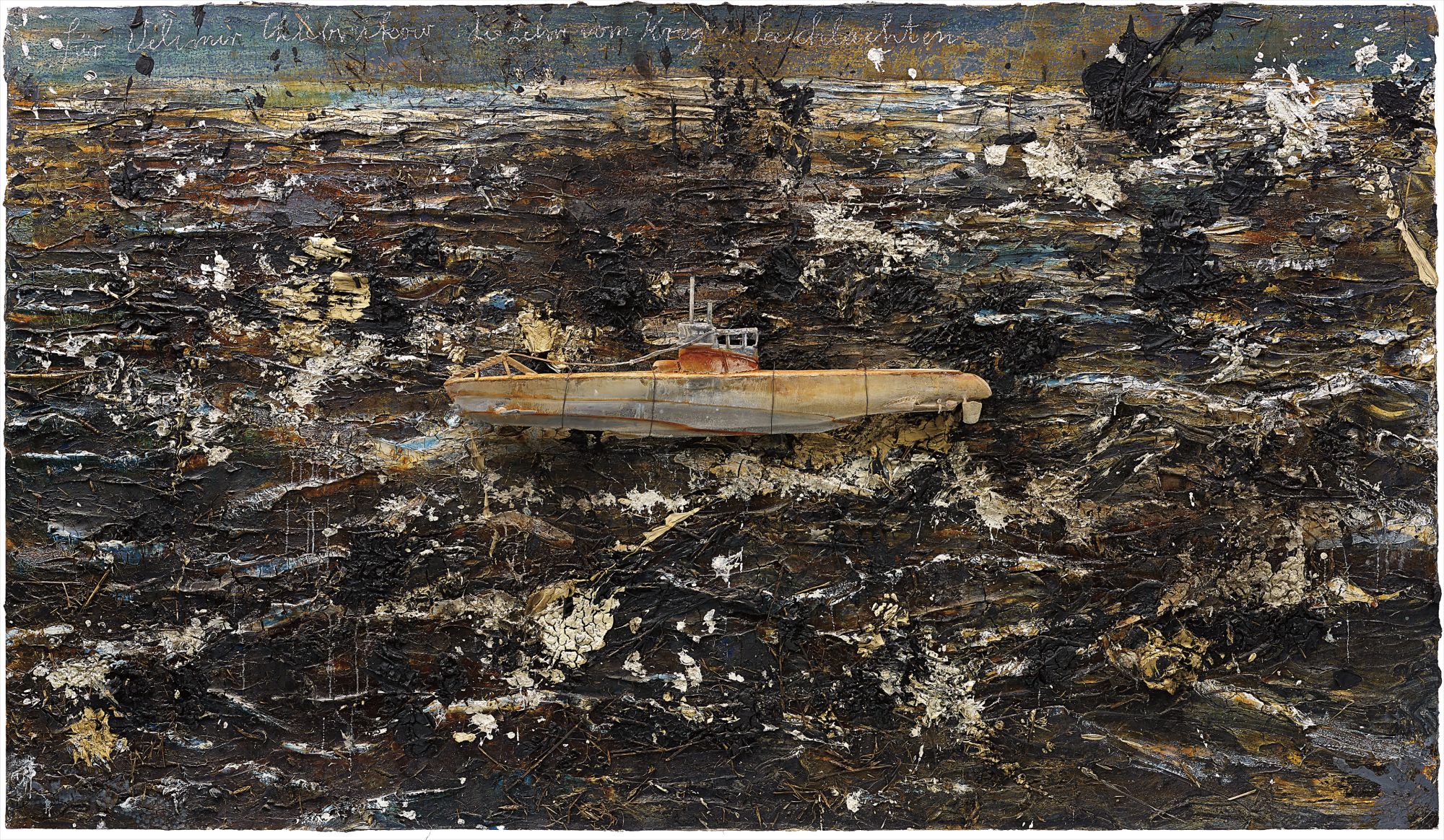

11
Anselm Kiefer
Für Velimir Khlebnikov: Die Lehre vom Krieg: Seeschlachten
paint, emulsion, shellac, straw on canvas, lead boat
190 x 330 cm (74 3/4 x 129 7/8 in.)
Titled "Für Velimir Khlebnikov: Die Lehre vom Krieg: Seeschlachten" along the upper edge.
Full-Cataloguing
Anselm Kiefer’s visually complex and multivalent work, Für Velimir Khlebnikov: Die Lehre vom Krieg: Seeschlachten translates into For Velimir Khlebnikov: The doctrine of War: Battles. The canvas is from a series of 30, all revolving around the quixotic work of famed Russian poet and Futurist Velimir Khlebnikov (1895-1922). Khlebnikov was a member of the Russian Avant-garden movement Hylaea. Captivated by both Slavic mythology and Pythagorean numerology, he produced a canon of experimental poems, and through arcane mathematics, a series of elaborate theories known as the Tables of Destiny. In these, Khlebnikov explored the idea of the cyclical recurrence of sea battles, eventually producing an estimate of a 317 year cycle. While the legitimacy of these estimates has been questioned, by academics and even Kiefer himself, Khlenbnikov’s driving desire to program history and give it a fixed form has captivated many.
It is this desire that is explored by Kiefer, in addition to a greater question on the march of history. This canvas, heaving with matter, possesses the characteristic turbid and highly worked surface of the artist’s work. Heavy impasto layers of burnt umber, smoky charcoal and black, alive with unseen forces, surround a handmade lead submarine, perched precariously amidst the turbulent seas. The oceanic depths are neither cerulean nor serene, but opaque, thickly layered and encrusted, demonstrating the sea’s capacity for sudden and violent transformation. This sheer power echoes the scenes of Caspar David Friedrich’s 1824 The Polar Sea. A uniform sense of futility and isolation permeates the scene, as the submarine floats without any other object in sight, wandering almost aimlessly. There is a suggestion in this work, through its hidden depths, of the unknowable and our fundamental inability to predict the future.
The dark tonality of the work is both brooding and chaotic, akin to Albrecht Dürer’s Apocalypse with Pictures woodcuts from the Book of Revelation. Much of Kiefer’s art is influenced by an exploration of his own German national psyche, the country’s artistic heritage and the enduring influence of both World Wars. This work represents an extension of these ideas, evoking the relations and trauma of the past, present and future in a three dimensional piece. Through this canvas, Kiefer is presenting a moment of coagulation within the theatre of the historic sea battle. The cycle of birth, death and rebirth is tangible, as a pale glimmer on the horizon provides a break against the overall desolation and a potential path for a more hopeful vision of the future. For as the artist exclaimed, 'I make a hole [in history] and pass through.' (A. Kiefer, quoted in Anselm Kiefer, exh. cat., Royal Academy of Art, London, 2014, p. 46).
It is this desire that is explored by Kiefer, in addition to a greater question on the march of history. This canvas, heaving with matter, possesses the characteristic turbid and highly worked surface of the artist’s work. Heavy impasto layers of burnt umber, smoky charcoal and black, alive with unseen forces, surround a handmade lead submarine, perched precariously amidst the turbulent seas. The oceanic depths are neither cerulean nor serene, but opaque, thickly layered and encrusted, demonstrating the sea’s capacity for sudden and violent transformation. This sheer power echoes the scenes of Caspar David Friedrich’s 1824 The Polar Sea. A uniform sense of futility and isolation permeates the scene, as the submarine floats without any other object in sight, wandering almost aimlessly. There is a suggestion in this work, through its hidden depths, of the unknowable and our fundamental inability to predict the future.
The dark tonality of the work is both brooding and chaotic, akin to Albrecht Dürer’s Apocalypse with Pictures woodcuts from the Book of Revelation. Much of Kiefer’s art is influenced by an exploration of his own German national psyche, the country’s artistic heritage and the enduring influence of both World Wars. This work represents an extension of these ideas, evoking the relations and trauma of the past, present and future in a three dimensional piece. Through this canvas, Kiefer is presenting a moment of coagulation within the theatre of the historic sea battle. The cycle of birth, death and rebirth is tangible, as a pale glimmer on the horizon provides a break against the overall desolation and a potential path for a more hopeful vision of the future. For as the artist exclaimed, 'I make a hole [in history] and pass through.' (A. Kiefer, quoted in Anselm Kiefer, exh. cat., Royal Academy of Art, London, 2014, p. 46).